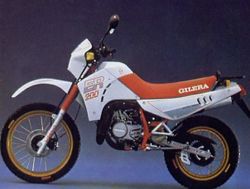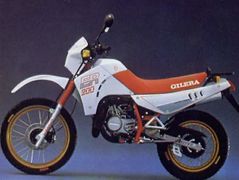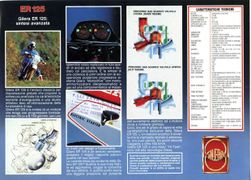Difference between revisions of "Gilera ER200"
(template fixes) |
|||
| Line 51: | Line 51: | ||
It came with a 2.75-21 front [[tire]] and a 4.60-17 rear tire. Stopping was achieved via Single 240mm disc in the front and a Drum in the rear. The front suspension was a Telescopic forks while the rear was equipped with a Alloy swing arm adjustable single shock. The ER200 was fitted with a 15 Liters / 3.9 US gal fuel tank. The bike weighed just 122 kg / 275 lbs. | It came with a 2.75-21 front [[tire]] and a 4.60-17 rear tire. Stopping was achieved via Single 240mm disc in the front and a Drum in the rear. The front suspension was a Telescopic forks while the rear was equipped with a Alloy swing arm adjustable single shock. The ER200 was fitted with a 15 Liters / 3.9 US gal fuel tank. The bike weighed just 122 kg / 275 lbs. | ||
== Photos == | == Photos == | ||
<gallery mode='packed-hover'> | |||
File:GIlera-ER200.jpg|600px|Gilera ER200 | |||
File:Gelera-ER-125--1.jpg|600px|Gilera ER200 | |||
</gallery> | |||
== Overview == | == Overview == | ||
This time in fact we deal with three separate models but presented in the same period, indeed on the same day, and united by the same engine, as well as by the chassis and a very similar bike. These were times when a house could afford the luxury of presenting three models on the same day. Moreover, the production of these three models in question, which were well differentiated, was of little cost burden, as the most expensive components (starting with the engine) were identical for all three. The date is 4 December 1986, the place of the Ferrari track of Fiorano. If you think then that only a few days later, at the Bologna Motor Show, the house of Arcore would have presented the RC 125 model you have an idea of the past splendours of this glorious company, today condemned to be a gregarious of the Piaggio Group that produces only Scooter. Starting from the engine, this was the same one mounted on the Gilera KZ and KK 125. It measured 56 mm of bore for 50.5 of a stroke, for a displacement of 124.3 cc and was equipped with a mechanical exhaust valve APTS. If on the roads it delivered 26 hp at 9,000 rpm and a torque of 2.1 kgm at 8,750 rpm, on the enduro models, maintaining the Power supply with DellOrto PHBH 28 carburetor but using a different exhaust, the power dropped to 25 hp, delivered at 8,750 laps, while the value of Maximum torque remained unchanged, but was delivered at 8,500 rpm. Identical also the frame, a double cradle continues in square steel tubes. Different were the use destinations and the inspiring concepts, as well as a part of cycling and components. The ER 125, also available in the displacement 200, was basically the heir to the RTX 125. It was therefore a classic enduro with high front fender and mask, although the latter had a more aerodynamic and less square look. Its vital measurements were: 2,180 mm long, 910 mm wide, 1,375 mm axis, saddle height 870 mm and dry weight of 119 kg, while the tank had a capacity of 15 liters. The Paioli fork, as on the latest RX, had the stems of 35 mm and a 220 mm run, while the rear suspension with Gilera Monodrive system and single shock had a 200 mm excursion. The wheels were steel but aluminum wheels were available as an option. The tyres measured 2.75x21 and 4.75x17 and were tubeless only paired with alloy wheels. The rear circle of 18 for a more 17-foot-17 was then abandoned. The brakes were 240 mm disc in front and 140 mm drum behind. The available colours were white or blue, both with red saddles, while the price was 3,905,000 lire, plus 295,000 lire for optional electric starter. | |||
The RRT Nebraska was the heir to the Arizona Hawk and was | |||
kept the evocative spirit, changing the American state to | |||
which it was dedicated to, but also much more and much more substantial. | |||
Nebraska experiences the complete fairing with | |||
mask attached to the frame along with the rest of the hull and not | |||
more to the fork, following a little Dakariana fashion at the end | |||
Eighties. | |||
The fender, however, remained | |||
high, while on many other similar models of the time was | |||
attached to the front wheel. Characteristics also | |||
some dakarian accessories, actually more than the tinsel | |||
aesthetics but very guessed: the front headlight had a | |||
protection grid, which actually protected very little being | |||
consists of only two horizontal irons, while in the part | |||
a plastic paramotor appeared, which served more to | |||
close the design of the hull that to actually protect | |||
plinth. | |||
The RRT's measures were | |||
identical to those of the ER, with a weight of 2 kg, so | |||
how identical was the capacity of the tank. Its price was | |||
ER of only 150,000 lire, while | |||
colors were always two, though to be honest the | |||
Nebraska on saw almost exclusively in the eye-catching blue/white version | |||
saddle and the bottom of the red flanks, while less | |||
success had the black/red coloring. Contrary to the ER | |||
a 200 version was not made. | |||
Major differences were | |||
on the Fastbike 125, which was not an enduro | |||
all the effects. In practice, it can be considered as | |||
a supernova of the supermotard, although at the time the term | |||
more widespread was funbike. Gilera herself called it at the time | |||
a multirole bike. | |||
The fashion of supermotards | |||
was yet to arrive, but meanwhile beyond the Alps wax already | |||
someone who was starting to mount sports hoops on motorcycles from | |||
Enduro. Yamaha also soon followed the same path with the | |||
Nebraska | |||
TDR 250. | TDR 250. | ||
READ ALSO > Amarcord: Yamaha TDR 250 | |||
Aesthetically more similar to the ER, the Fastbike had | |||
one more road, emphasized by the front fender | |||
low and especially from the 18-square-tinted circle, coupled with one | |||
17 at the back, with 90/90 and 4.70 tyres, decidedly | |||
atypical on a supermotard today. The suspensions had | |||
so a smaller run: 200 mm in front and 140 mm at the back. | |||
The braking system, on the other hand, could count on a rear disc | |||
230 mm instead of the drum. | |||
Speaking of measures, those | |||
Fastbike were only slightly different from the Fastbike's | |||
her most off-road colleagues: the interinterasse was longer than | |||
10 mm (1 | 10 mm (1,385), while the saddle was slightly lower (850 | ||
The price of the Fastbike 125, which was also available | |||
in the 200 version, was identical to that of rRT Nebraska and | |||
was sold in two colours: blue or white, both with | |||
friezes and red saddle. | |||
Declared benefits | |||
were almost identical for all three bikes: 130 km/h for | |||
ER, 132 km/h for Nebraska and 134 km/h for the Fastbike, with | |||
acceleration from 0 to 100 km/h of 9.4 seconds and equal consumption | |||
25.2 km/litre. These three models were not actually | |||
very long-lived and suffered from internal competition from other | |||
successful enduro models of the House of Arcore, which came out of | |||
shortly there, including the RC 125 (presented as mentioned some | |||
Days later), the R1 and the XR1 (both presented in 1988). | |||
For the Fastbike, the times were | |||
decidedly unripe. His heir arrived in 1991: | |||
called Freestyle and was strictly derived from the Apache | |||
125, in turn heir to the RC Top Rally. | |||
==Specifications== | |||
{| class="wikitable" | {| class="wikitable" | ||
|- | |- | ||
| Line 264: | Line 198: | ||
|} | |} | ||
[[Category:Gilera motorcycles]] | [[Category:Gilera motorcycles]] | ||
Revision as of 03:18, 2 December 2019
 |
|
| Gilera ER200 | |
| Manufacturer | |
|---|---|
| Production | 1987 |
| Engine | Two stroke, single cylinder |
| Compression ratio | 9.5:1 |
| Ignition | Electronic |
| Transmission | 6 Speed |
| Suspension | Front: Telescopic forks Rear: Alloy swing arm adjustable single shock |
| Brakes | Front: Single 240mm disc Rear: Drum |
| Front Tire | 2.75-21 |
| Rear Tire | 4.60-17 |
| Weight | 122 kg / 275 lbs (dry), |
| Fuel Capacity | 15 Liters / 3.9 US gal |
| Manuals | Service Manual |
Engine
The engine featured a 9.5:1 compression ratio.
Chassis
It came with a 2.75-21 front tire and a 4.60-17 rear tire. Stopping was achieved via Single 240mm disc in the front and a Drum in the rear. The front suspension was a Telescopic forks while the rear was equipped with a Alloy swing arm adjustable single shock. The ER200 was fitted with a 15 Liters / 3.9 US gal fuel tank. The bike weighed just 122 kg / 275 lbs.
Photos
Overview
This time in fact we deal with three separate models but presented in the same period, indeed on the same day, and united by the same engine, as well as by the chassis and a very similar bike. These were times when a house could afford the luxury of presenting three models on the same day. Moreover, the production of these three models in question, which were well differentiated, was of little cost burden, as the most expensive components (starting with the engine) were identical for all three. The date is 4 December 1986, the place of the Ferrari track of Fiorano. If you think then that only a few days later, at the Bologna Motor Show, the house of Arcore would have presented the RC 125 model you have an idea of the past splendours of this glorious company, today condemned to be a gregarious of the Piaggio Group that produces only Scooter. Starting from the engine, this was the same one mounted on the Gilera KZ and KK 125. It measured 56 mm of bore for 50.5 of a stroke, for a displacement of 124.3 cc and was equipped with a mechanical exhaust valve APTS. If on the roads it delivered 26 hp at 9,000 rpm and a torque of 2.1 kgm at 8,750 rpm, on the enduro models, maintaining the Power supply with DellOrto PHBH 28 carburetor but using a different exhaust, the power dropped to 25 hp, delivered at 8,750 laps, while the value of Maximum torque remained unchanged, but was delivered at 8,500 rpm. Identical also the frame, a double cradle continues in square steel tubes. Different were the use destinations and the inspiring concepts, as well as a part of cycling and components. The ER 125, also available in the displacement 200, was basically the heir to the RTX 125. It was therefore a classic enduro with high front fender and mask, although the latter had a more aerodynamic and less square look. Its vital measurements were: 2,180 mm long, 910 mm wide, 1,375 mm axis, saddle height 870 mm and dry weight of 119 kg, while the tank had a capacity of 15 liters. The Paioli fork, as on the latest RX, had the stems of 35 mm and a 220 mm run, while the rear suspension with Gilera Monodrive system and single shock had a 200 mm excursion. The wheels were steel but aluminum wheels were available as an option. The tyres measured 2.75x21 and 4.75x17 and were tubeless only paired with alloy wheels. The rear circle of 18 for a more 17-foot-17 was then abandoned. The brakes were 240 mm disc in front and 140 mm drum behind. The available colours were white or blue, both with red saddles, while the price was 3,905,000 lire, plus 295,000 lire for optional electric starter.
The RRT Nebraska was the heir to the Arizona Hawk and was kept the evocative spirit, changing the American state to which it was dedicated to, but also much more and much more substantial. Nebraska experiences the complete fairing with mask attached to the frame along with the rest of the hull and not more to the fork, following a little Dakariana fashion at the end Eighties. The fender, however, remained high, while on many other similar models of the time was attached to the front wheel. Characteristics also some dakarian accessories, actually more than the tinsel aesthetics but very guessed: the front headlight had a protection grid, which actually protected very little being consists of only two horizontal irons, while in the part a plastic paramotor appeared, which served more to close the design of the hull that to actually protect plinth. The RRT's measures were identical to those of the ER, with a weight of 2 kg, so how identical was the capacity of the tank. Its price was ER of only 150,000 lire, while colors were always two, though to be honest the Nebraska on saw almost exclusively in the eye-catching blue/white version saddle and the bottom of the red flanks, while less success had the black/red coloring. Contrary to the ER a 200 version was not made. Major differences were on the Fastbike 125, which was not an enduro all the effects. In practice, it can be considered as a supernova of the supermotard, although at the time the term more widespread was funbike. Gilera herself called it at the time a multirole bike. The fashion of supermotards was yet to arrive, but meanwhile beyond the Alps wax already someone who was starting to mount sports hoops on motorcycles from Enduro. Yamaha also soon followed the same path with the TDR 250. READ ALSO > Amarcord: Yamaha TDR 250 Aesthetically more similar to the ER, the Fastbike had one more road, emphasized by the front fender low and especially from the 18-square-tinted circle, coupled with one 17 at the back, with 90/90 and 4.70 tyres, decidedly atypical on a supermotard today. The suspensions had so a smaller run: 200 mm in front and 140 mm at the back. The braking system, on the other hand, could count on a rear disc 230 mm instead of the drum. Speaking of measures, those Fastbike were only slightly different from the Fastbike's her most off-road colleagues: the interinterasse was longer than 10 mm (1,385), while the saddle was slightly lower (850 The price of the Fastbike 125, which was also available in the 200 version, was identical to that of rRT Nebraska and was sold in two colours: blue or white, both with friezes and red saddle. Declared benefits were almost identical for all three bikes: 130 km/h for ER, 132 km/h for Nebraska and 134 km/h for the Fastbike, with acceleration from 0 to 100 km/h of 9.4 seconds and equal consumption 25.2 km/litre. These three models were not actually very long-lived and suffered from internal competition from other successful enduro models of the House of Arcore, which came out of shortly there, including the RC 125 (presented as mentioned some Days later), the R1 and the XR1 (both presented in 1988).
For the Fastbike, the times were decidedly unripe. His heir arrived in 1991: called Freestyle and was strictly derived from the Apache 125, in turn heir to the RC Top Rally.
Specifications
| Make Model | Gilera ER 200 |
|---|---|
| Year | 1987 |
| Engine Type | Two stroke, single cylinder |
| Displacement | 183 cc / 11.1 cu-in |
| Bore X Stroke | 68 x 50.5 mm |
| Compression | 9.5:1 |
| Induction | Dell'Orto premix |
| Ignition | Electronic |
| Starting | Kick |
| Max Power | 26 hp / 19 kW @ 7500 rpm |
| Max Torque | |
| Transmission | 6 Speed |
| Final Drive | Chain |
| Front Suspension | Telescopic forks |
| Rear Suspension | Alloy swing arm adjustable single shock |
| Front Brakes | Single 240mm disc |
| Rear Brakes | Drum |
| Front Tire | 2.75-21 |
| Rear Tire | 4.60-17 |
| Dry Weight | 122 kg / 275 lbs |
| Fuel Capacity | 15 Liters / 3.9 US gal |

